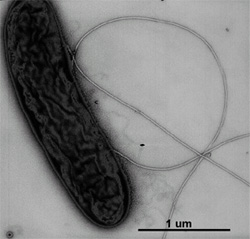Geobacter
A Microbial Biorealm page on the genus Geobacter

Classification
Higher order taxa:
Bacteria; Proteobacteria; delta/epsilon subdivisions; Deltaproteobacteria; Desulfuromonadales; Geobacteraceae
Species:
G. bemidjiensis, G. bremensis, G. chapelleii, G. grbiciae, G. humireducens, G. hydrogenophilus, G. metallireducens sp., G. pelophilus, G. sulfurreducens sp., G. sp.
Description and Significance
Geobacter is rod-shaped with flagella and is known to have unusual electron transfer and environmental restorative capabilities, giving it several industrial uses.
Genome Structure
The sequencing of Geobacter sulfurreducens has led to new discoveries about the capabilities of Geobacter. Through this sequencing, it has been found that Geobacter has the ability to move towards metallic compounds. Geobacter has also been discovered to have genes allowing it to function in the presence of oxygen. It appears that Geobacter has over 100 genes that encode various c-type cytochrome forms. This variety of c-type cytochromes is what allows Geobacter to reduce metals and create electricity (EurekAlert, 2003).
Cell Structure and Metabolism

G. metallireducens was the first organism found to respire on organic compounds using iron oxide as an electron acceptor. One such compound is petroleum contaminants in polluted ground water, which Geobacter destroys through oxidation. Geobacter can remove radioactive metals from ground water by reducing metal ions as well. Geobacter has also been found to have the capacity to gain electricity from mud and other inorganic waste matter forms. Through iron oxides that Geobacter obtains, Geobacter helps to provide a model for iron transformations (Geobacter Project, 2004).
Ecology
Geobacter was first isolated in 1987 from the Potomac River (Geobacter Project, 2004). G. sulfurreducens was later found in a soil sample contaminated by hydrocarbons in Oklahoma (EurekAlert, 2003). When a sedimentary environment contains acetate as the electron donor, typically a Geobacter species is discovered as the iron reducer (D. Lovley, 2004). Derek Lovely's lab group has many studies showing the use of Geobacter strains donating electrons to electrodes in fuel cells to generate electricity.
References
Genome News Network. 26 Apr 2002. Metal-eating microbe Geobacter metallireducens swims.
